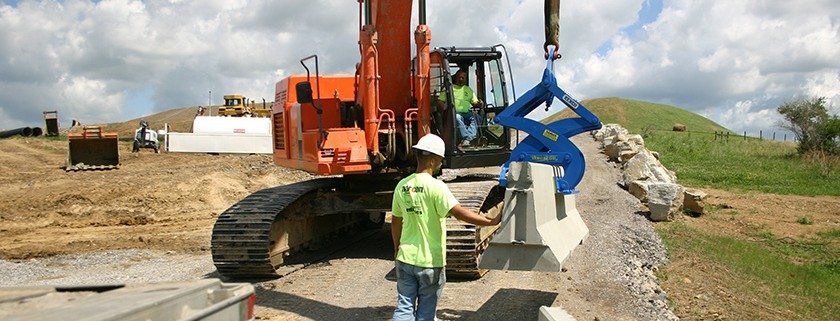Which Kenco Barrier Lift do I Need?
Barrier walls come in a vast array of shapes and sizes. There are many different concrete barrier walls in use today. Some states share the same barrier wall design; other states use several different designs. Choosing the right concrete barrier lifter or jersey barrier picker is not difficult. Here are a few parameters that you need to know before choosing the correct Kenco Barrier Lift:
- The weight of the concrete barrier.
- The dimension across the top. To get this dimension, extend a straight edge up each side past the top of the wall (this will give the most accurate measurement, as most barrier walls have a small radius on the top corners), then measure across the top to each straight edge. You can use the print that is available from the manufacturer of the precast concrete barrier wall as well.
If there is any doubt to your particular barrier wall, send a copy of the print to sales@kenco.com and we will make the determination for you.
How do I determine the specifications of my current Kenco barrier lifter?
Kenco Barrier Lifters have a Serial Tag with information that includes the serial number, weight capacity and dimensional range. If for some reason the serial tag becomes unreadable, destroyed or is missing, the serial number is also stamped into the lift bail or a crossing member on the top surface of the barrier lifter, which we can use to track needed information. Feel free to call with any questions regarding the use of our barrier lifter.
What other considerations should be taken into account?
Remember, just because the lifter fits over the wall doesn’t mean it will lift the wall safely. It is up to the end user or operator to verify the correct sizing. For instance, if you were to use our old model KL9000 with a 6” to 9” range on a precast concrete barrier wall that weighed 7,200 pounds and correctly measured to 9-1/4”. The lifter may fit over the barrier and have enough capacity, but the problem is that the automatic actuator may not stroke far enough to rotate the correct amount to let it release. The barrier lifter may incorrectly pick up the concrete barrier wall, because the pads will rotate and cam them into the barrier. This will cause damage to the barrier lifter and it could possibly drop the barrier wall, which may seriously injure site personnel. In this case, the old style KL9000 with a 9” to 12” range was recommended.
Since 2014, all standard models of the barrier lift are manufactured with a 6 to 12 inch grip range, wider pads to increase total surface contact, a fuller pad angle rotation to accurately contour to the wall slope, and integrated handles on both sides of the lifter. The older models are now obsolete, though it may take some time, because some companies are still using Kenco jersey barrier pickers that were purchased over twenty years ago.




Leave a Reply
Want to join the discussion?Feel free to contribute!